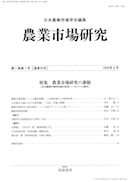Volume 18, Issue 2
Displaying 1-11 of 11 articles from this issue
- |<
- <
- 1
- >
- >|
Paper
-
Article type: Paper
2009 Volume 18 Issue 2 Pages 1-10
Published: September 30, 2009
Released on J-STAGE: June 22, 2020
Download PDF (1185K) -
Article type: Paper
2009 Volume 18 Issue 2 Pages 11-20
Published: September 30, 2009
Released on J-STAGE: June 22, 2020
Download PDF (1159K) -
Article type: Paper
2009 Volume 18 Issue 2 Pages 21-33
Published: September 30, 2009
Released on J-STAGE: June 22, 2020
Download PDF (1136K) -
Article type: Paper
2009 Volume 18 Issue 2 Pages 34-45
Published: September 30, 2009
Released on J-STAGE: June 22, 2020
Download PDF (1331K) -
Article type: Paper
2009 Volume 18 Issue 2 Pages 46-52
Published: September 30, 2009
Released on J-STAGE: June 22, 2020
Download PDF (735K) -
Article type: Paper
2009 Volume 18 Issue 2 Pages 53-59
Published: September 30, 2009
Released on J-STAGE: June 22, 2020
Download PDF (768K) -
Article type: Paper
2009 Volume 18 Issue 2 Pages 60-66
Published: September 30, 2009
Released on J-STAGE: June 22, 2020
Download PDF (772K) -
Article type: Paper
2009 Volume 18 Issue 2 Pages 67-73
Published: September 30, 2009
Released on J-STAGE: June 22, 2020
Download PDF (747K) -
Article type: Paper
2009 Volume 18 Issue 2 Pages 74-79
Published: September 30, 2009
Released on J-STAGE: June 22, 2020
Download PDF (677K) -
Article type: Paper
2009 Volume 18 Issue 2 Pages 88-94
Published: September 30, 2009
Released on J-STAGE: June 22, 2020
Download PDF (781K) -
Article type: Paper
2009 Volume 18 Issue 2 Pages 95-99
Published: September 30, 2009
Released on J-STAGE: June 22, 2020
Download PDF (581K)
- |<
- <
- 1
- >
- >|
